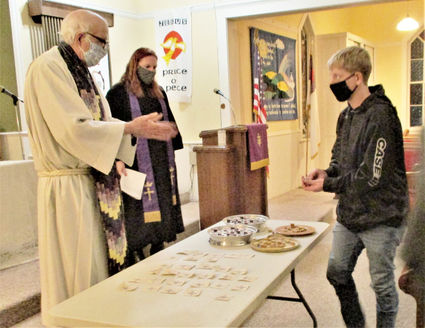Ash Wednesday 2021 observed in midst of pandemic
March 3, 2021

(Left to right) Reverend Jack Mattingly and Reverend Maggie Lewis offer the sacraments of the Lord's Supper and a cross of ashes imposed on a piece of cloth to J.J. Farris. Farris was visiting from Kansas and joined in the Ash Wednesday service. Imposing ashes on a piece of cloth instead of a worshipper's forehead was a change to assure social distancing during the COVOD-19 pandemic.
Two local churches continued a long standing tradition of a combined Ash Wednesday service. Ash Wednesday 2021 was celebrated between the Chinook United Methodist Church and the Presbyterian Church of Chinook. Pastor Jack Mattingly, with UMC, and Rev. Maggie Lewis, with the Presbyterian Church, led the service. Several other local congregations also held Ash Wednesday services commemorating the beginning of Lent.
This year's Ash Wednesday celebration for the Methodists and Presbyterians was a bit different as worshippers dealt with the realities of COVID-19. With concerns about social distancing and many locals still wearing protective masks, the mechanics of the traditional imposition of ashes was modified. Normally the minister dips their finger in to ashes, then makes draws the sign of the cross on each congregant's forehead. This year the cross was drawn on a separate piece of cloth so worshippers could carry it home for display but with no social contact between minister and congregant.
Ash Wednesday is not mentioned in the Christian Bible. Through tradition and church practices the observance for many Christian denominations marks the beginning of Lent leading to the celebration of Christ's resurrection on Easter Sunday. Lent begins on the Wednesday forty days before Easter (Sundays are not included in the forty day count) and is a time of spiritual reflection and self-examination for members of a faith community. The service is typically somber as the faithful begin a period of preparation for Easter.
The exact history of how Ash Wednesday began is murky but most scholars agree it became a common practice in Christian churches during the middle ages. Ancients, in old testament times, covered themselves in ashes as a personal indicator of repentance and a public sign of a desire to change. Later the imposition of ashes became a sign, at the beginning of Lent, of a desire by faith communities to repent, contemplate their shortcomings and begin a process of spiritual healing.
The symbolic use of ashes in the Bible ranges from the old testament practice of covering oneself in ashes and 'sack cloth' to the current ash sign of the cross placed on the forehead. There is historical evidence that when the imposition of ashes first began clerics and male congregants would put ashes on the top of their heads while female worshippers had the sign of the cross imposed on their foreheads. Over time the ash sign on the forehead became commonly accepted.
A number of interesting 'legends' surrounds Ash Wednesday. Aelfric, an early Christian writer, documented imposition of ashes in the early church and how it tied to the practices in the old testament. He illustrated the importance of the ceremony with a story about a man who refused to go to church for the ash ceremony and was killed a few days later on a boar hunt. A more recent tradition found in many churches is to save palms from Palm Sunday, dry them and then burn the palms to create ashes for next year's Ash Wednesday service.
Like most religious practices, the imposition of ashes has evolved and is still changing. Just a few years ago several groups of Christians, world-wide, decided to "take the imposition of ashes to where the people are." Around the United States these groups stood where people were streaming by and offered a "brief moment of grace and spiritual refection" by imposing ashes in public places such as commuter train stations and busy street corners.
Groups practicing this "outreach of Ash Wednesday" maintain a website and Facebook pages where they list sites where the ashes are offered. The online sites have pictures and reactions from penitents who received the ashes. This year, with the pandemic, groups have adapted to meet local public health concerns (see the website at: ashestogo.org). To date no Montana sites have been listed as offering the outreach program on Ash Wednesday.







